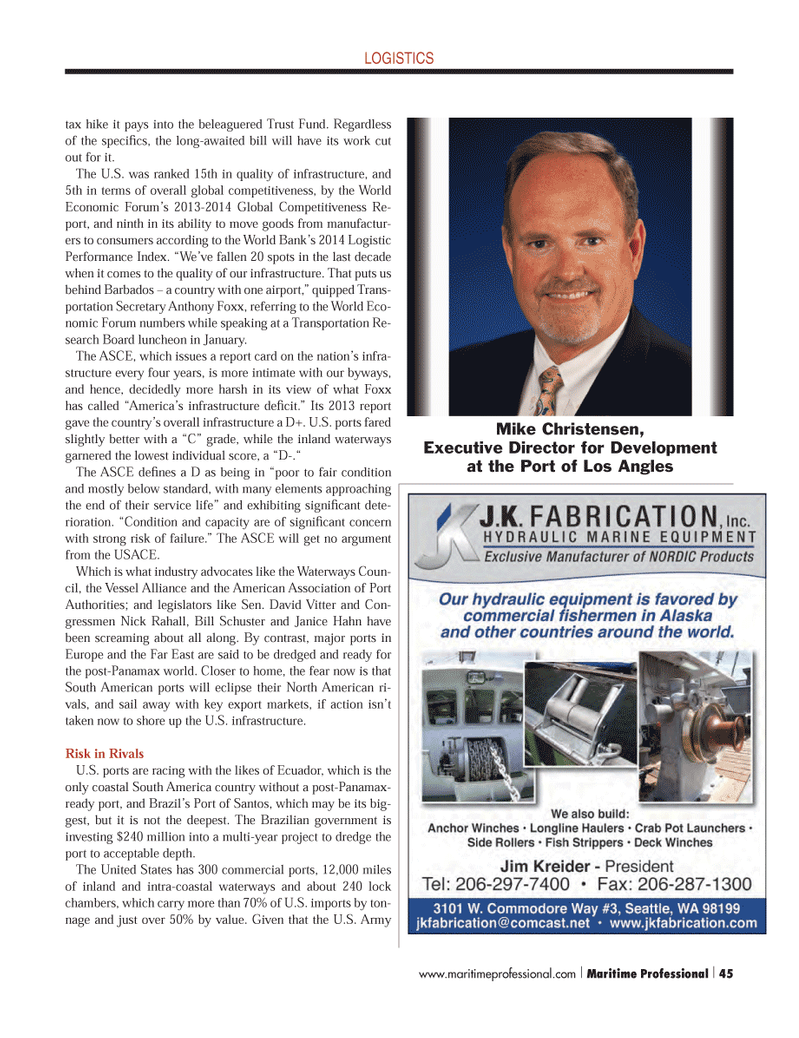
Page 45: of Maritime Logistics Professional Magazine (Q2 2014)
Maritime Risk & Shipping Finance
Read this page in Pdf, Flash or Html5 edition of Q2 2014 Maritime Logistics Professional Magazine
LOGISTICS tax hike it pays into the beleaguered Trust Fund. Regardless of the specifi cs, the long-awaited bill will have its work cut out for it.
The U.S. was ranked 15th in quality of infrastructure, and 5th in terms of overall global competitiveness, by the World
Economic Forum’s 2013-2014 Global Competitiveness Re- port, and ninth in its ability to move goods from manufactur- ers to consumers according to the World Bank’s 2014 Logistic
Performance Index. “We’ve fallen 20 spots in the last decade when it comes to the quality of our infrastructure. That puts us behind Barbados – a country with one airport,” quipped Trans- portation Secretary Anthony Foxx, referring to the World Eco- nomic Forum numbers while speaking at a Transportation Re- search Board luncheon in January.
The ASCE, which issues a report card on the nation’s infra- structure every four years, is more intimate with our byways, and hence, decidedly more harsh in its view of what Foxx has called “America’s infrastructure defi cit.” Its 2013 report gave the country’s overall infrastructure a D+. U.S. ports fared slightly better with a “C” grade, while the inland waterways garnered the lowest individual score, a “D-.“
The ASCE defi nes a D as being in “poor to fair condition and mostly below standard, with many elements approaching the end of their service life” and exhibiting signifi cant dete- rioration. “Condition and capacity are of signifi cant concern with strong risk of failure.” The ASCE will get no argument from the USACE.
Which is what industry advocates like the Waterways Coun- cil, the Vessel Alliance and the American Association of Port
Authorities; and legislators like Sen. David Vitter and Con- gressmen Nick Rahall, Bill Schuster and Janice Hahn have been screaming about all along. By contrast, major ports in
Europe and the Far East are said to be dredged and ready for the post-Panamax world. Closer to home, the fear now is that
South American ports will eclipse their North American ri- vals, and sail away with key export markets, if action isn’t taken now to shore up the U.S. infrastructure.
Risk in Rivals
U.S. ports are racing with the likes of Ecuador, which is the only coastal South America country without a post-Panamax- ready port, and Brazil’s Port of Santos, which may be its big- gest, but it is not the deepest. The Brazilian government is investing $240 million into a multi-year project to dredge the port to acceptable depth.
The United States has 300 commercial ports, 12,000 miles of inland and intra-coastal waterways and about 240 lock chambers, which carry more than 70% of U.S. imports by ton- nage and just over 50% by value. Given that the U.S. Army
Mike Christensen,
Executive Director for Development at the Port of Los Angles www.maritimeprofessional.com | Maritime Professional | 45 34-49 Q2 MP2014.indd 45 5/19/2014 9:23:51 AM

 44
44

 46
46
